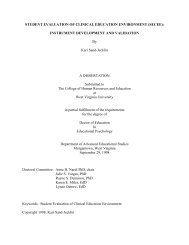The Use of Native Plants for Revegetation along West Virginia ...
The Use of Native Plants for Revegetation along West Virginia ...
The Use of Native Plants for Revegetation along West Virginia ...
Create successful ePaper yourself
Turn your PDF publications into a flip-book with our unique Google optimized e-Paper software.
Much research has been done on using native plants on roadsides (Ahern et al. 1992, Barton<br />
et al. 2002, Corley 1995, Fiedler et al. 1990, Harper 1988, Morrison 1981, Swan et al. 1993).<br />
Many have found it to be a viable and economical option.<br />
<strong>The</strong> goals <strong>of</strong> this research are:<br />
1) To identify native plants suitable <strong>for</strong> seeding <strong>along</strong> highways and document<br />
the growth and establishment <strong>of</strong> these species on highway cut and fill sites.<br />
2) To develop methods to enhance native species establishment in roadside<br />
2. Literature Review<br />
environments.<br />
3) To correlate the establishment <strong>of</strong> native plants used <strong>for</strong> highway revegetation<br />
to physical and chemical soil properties.<br />
2.1. Current <strong>West</strong> <strong>Virginia</strong> Division <strong>of</strong> Highways (WVDOT) <strong>Revegetation</strong> Practices<br />
Most state highway departments have developed revegetation strategies through years <strong>of</strong><br />
testing. <strong>The</strong> mountainous nature <strong>of</strong> <strong>West</strong> <strong>Virginia</strong> makes the construction <strong>of</strong> highways very<br />
similar to surface mining. To maintain moderate grades, the mountainous topography is blasted<br />
and the blasted rock material is then used to backfill lower areas. <strong>The</strong> topsoil is removed and<br />
kept separate to be placed only when the entire roadway is finished. Topsoil may also be<br />
obtained and hauled from sites outside <strong>of</strong> the construction area. Be<strong>for</strong>e placement, the subsoil is<br />
scarified to promote bonding with the topsoil. After spreading the soil, it is raked to remove all<br />
large clods, brush, litter, or other <strong>for</strong>eign material, and rocks larger than 2 inches (Facemire et al.,<br />
2000).<br />
<strong>The</strong> application <strong>of</strong> limestone is determined prior to seeding and is based on a lime<br />
requirement test. <strong>The</strong> area to be seeded is scarified to create a seed bed and seed is sown<br />
immediately. All legume seed is inoculated with appropriate cultures and when a hydroseeder is<br />
to be used, the inoculant is increased five times the normal rate. Rates and seeding combinations<br />
used by the WVDOT can be found in Table 1. Fertilizer is typically applied concurrently with<br />
the seeding at a rate <strong>of</strong> 1,120 kg/ha <strong>of</strong> 10-20-10. An additional 336 kg/ha <strong>of</strong> slow release urea<br />
2












